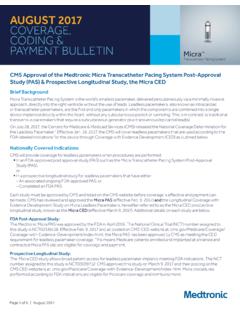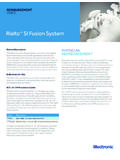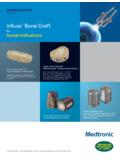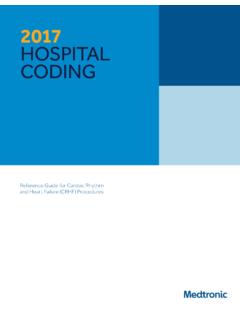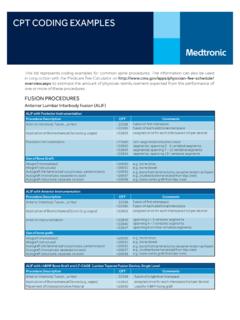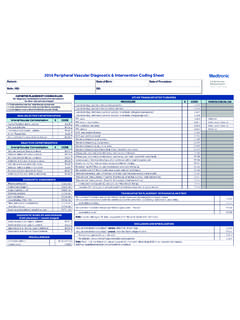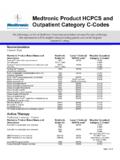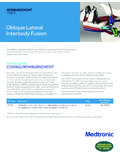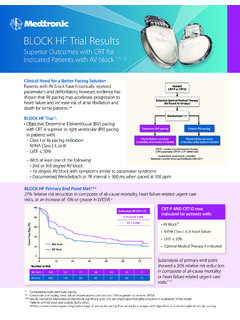Transcription of MRI SURESCAN SYSTEMS - Medtronic
1 PATIENT PRESCREENINGSureScan pacing , Defibrillation, and CRT (CRT-D and CRT-P) SYSTEMS VerificationVerify that patient has a complete SURESCAN pacing , defibrillation, or CRT system , which consists of an approved combination MRI SURESCAN device with SURESCAN lead(s) (Note: The model 6725 Pin Plug is MR conditional only for use in the atrial port on CRT devices), using one or more of the following methods: Use the patient records to verify a complete SURESCAN pacing , defibrillation, or CRT system has been implanted and MR conditions are met Use the patient ID card to identify the device and leads implanted, then verify MR conditional at Call Medtronic at 1 (800) 551-5544 to verify the patient s current implanted systemThe following are two optional methods that rely on complete and accurate information being entered.
2 Use the Patient Details page on the CareLink network to verify a complete SURESCAN pacing , defibrillation, or CRT system has been implanted Use the Patient Information window [for ICD: select MRI SURESCAN system /Other Hardware] on the programmer to verify a complete SURESCAN pacing , defibrillation, or CRT system has been implanted For a full list of devices and leads approved for the MRI environment, download our MR-conditional Cardiac Device Summary Chart, which can be found on SURESCAN SYSTEMSP atient Scanning Process Transvenous Implantable Cardiac SystemsCardiology ChecklistStep 1.
3 Patient prescreening requirements The patient has no implanted lead extenders, lead adaptors, or abandoned leads The patient has no broken leads or leads with intermittent electrical contact, as confirmed by lead impedance history. (Note: For Advisa MRI and Revo MRI pacemakers, the lead impedance value is 200 ohms ( ) and 1,500 ) The SURESCAN system is implanted in the left or right pectoral region Revo pacemaker system has been implanted for more than 6 weeks; all other SYSTEMS post-lead maturation period (approximately 6 weeks) The SURESCAN device is operating within the projected service life For patients whose device will be programmed to an asynchronous pacing mode when the MRI SURESCAN mode is programmed to On, no diaphragmatic stimulation is present when the paced leads have a pacing output of V and a pulse width of ms pacing capture thresholds V at ms (Revo MRI )Caution.
4 It is not recommended to perform an MRI scan if the right ventricular (RV) lead pacing capture threshold is greater than V at ms for pacemaker-dependent patients. A higher pacing capture threshold may indicate an issue with the implanted 2: Pre-scan programming requirements A health professional who has completed cardiology SURESCAN training must be present during the programming of the SURESCAN mode Provide doctor s order for pacing support needed and the appropriate pacing rate during SURESCAN operation For patients who require pacing support, the MRI pacing mode must be set to DOO, AOO, or VOO while the MRI SURESCAN feature is programmed On Tip.
5 If an asynchronous pacing mode is selected, an appropriate MRI SURESCAN pacing rate must be selected to avoid competitive pacing during the operation of MRI SURESCAN . Note: For pacemakers and CRT-P SYSTEMS , Atrial and RV pace polarities must be set to bipolar to program MRI SURESCAN mode to On. Note: For CRT SYSTEMS , when MRI SURESCAN mode is programmed to On, the patient receives no CRT support. This lack of CRT support might cause dizziness or shortness of breath. For patients who do not require pacing support, the MRI pacing mode should be set to ODO (OVO, for single chamber devices) while the MRI SURESCAN feature is programmed OnStep 3: Post-scan programming requirements Program SURESCAN mode Off after the MRI procedure; device returned to previous settings (see next page) Note: Do not leave the device in MRI SURESCAN mode after the scan is complete.
6 For CRT-D and ICD devices, while the MRI SURESCAN mode is programmed to On, arrhythmia detection and therapies are suspended, leaving the patient at risk of death from untreated spontaneous tachyarrhythmia. In addition, if the device is programmed to an asynchronous pacing mode, arrhythmia risk may be increased. Note: For CRT SYSTEMS , while the MRI SURESCAN mode is programmed to On, the patient receives no CRT support. This lack of CRT support might cause dizziness or shortness of breath. Check the pacing thresholds to ensure that there is a proper safety marginSureScan Programming StepsPrior to the MRI procedure1.
7 After accessing the Parameters screen, navigate to the MRI SURESCAN feature. 2. Select the check box in the upper-left corner to indicate all items on the MRI SURESCAN checklist are Select MRI SURESCAN programming field to On. Note: When MRI SURESCAN is programmed to On, all device diagnostic measurements and collection are suspended; the ICD or CRT-D system does not detect tachyarrhythmias and does not deliver tachyarrhythmia From here, you will need to: Program a mode (DOO, VOO, AOO, ODO, or OVO) Program a rate (for asynchronous modes only) Touch [PROGRAM] to complete the steps Touch [ ] for documentationRefer to the SURESCAN Programming Tip Card for more the MRI procedure1.
8 Interrogate the device, and you will be automatically brought to the SURESCAN programming Program SURESCAN Off. Pre-scan parameters are automatically Check the pacing capture threshold to ensure that there is a proper safety ChecklistStep 1: Schedule Contact cardiology to obtain clearance documents, including SURESCAN Programming Order, and the applicable SURESCAN conditions for use (including whether or not the patient is eligible for a or a 3T MRI scan) Schedule a health professional who will monitor heart rate of patient during MRI exam (with ECG or pulse oximetry).
9 A patient with a defibrillator or a CRT-D device must be monitored the entire time SURESCAN mode is programmed to On. Schedule a trained cardiology professional who will program the patient s pacemaker, defibrillator, or CRT system in and out of SURESCAN modeStep 2: Prep patient for scan Confirm a health professional who has completed radiology SURESCAN training is present Ensure device is programmed in SURESCAN mode prior to the MRI examinationStep 3: Conduct MRI scan using the following guidelines Horizontal field, cylindrical bore, clinical system for hydrogen proton imaging Static magnetic field of one of the following strengths (Refer to table 2 on the following page).
10 3T Maximum spatial gradient of 20 T/m (2000 gauss/cm) Gradient SYSTEMS with maximum gradient slew rate performance per axis of 200 T/m/sRadiology Checklist, cont MRI radiofrequency (RF) power3T MRI radiofrequency (RF) powerNormal Operating Mode Whole body averaged specific absorption rate (SAR) must be W/kg Head SAR must be W/kgFirst Level Controlled Operating Mode or Normal Operating Mode: B1+RMS must be T when the isocenter (center of the MRI bore) is inferior to the C7 vertebra Scans can be performed without B1+RMS restriction when the isocenter is at or superior to the C7 vertebra (see Figure 1)Table 2: MR Conditions of use for specific RF 4: Provide appropriate patient monitoring and rescue Pacemaker and CRT-P Requirements: Proper patient monitoring* must be provided during the MRI scan.
